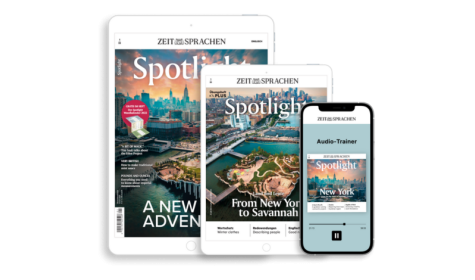Transcript: Driving Route 66
Mae: I’m here with James Draven, the author of our Route 66 travel article. Though I am from the US, I’ve never actually been to any of the places along Route 66 except for Chicago, which is the starting point of the route – is that correct?
James: Yeah, I mean you can do it both ways. I’ve driven it twice and, on both occasions, I’ve started in Chicago, yes.
Mae: When I was looking for it on the map today, I couldn’t find it. So, I’m curious, what do you think draws people to this route, even though you can’t find it on the map?
James: Do you know, I didn’t know you can’t find it on the map. When I drove it the first time, in particular, it was quite difficult to find the trail, and I ended up having to buy a sort of laminated souvenir map to find the trail. And indeed, outside of that area, outside of the areas around Route 66, when I spoke to, I mean, you say you haven’t driven it either, but when I spoke to Americans about it the first time I drove it, which was a decade ago, a lot of them hadn’t even heard of it. A lot of Americans were like, “What is Route 66? I’ve never heard of it.” And I was sort of since told that it’s more iconic in the consciousnessBewusstseinconsciousness of British and German travelers than it is in the U.S. Yeah, so that was interesting. And that’s all set to change very much so as it prepares for its 100th anniversary. Like, near-forgotten destinations along the route are spruce up sth. (ifml.)etw. herausputzen, auf Vordermann bringensprucing up their stretchStrecke, Abschnittstretches of highway. They’re repainting the Route 66 signs, you know, that are on the road itself, new museums are opening up in celebration of it because, you know, in a country with a relatively short history, a lot of pride is associated with the centenaryHundertjahrfeiercentenary, and so it’s kind of a big deal (ifml.)große Sachebig deal. It is a difficult road to find. It’s funny, you should say it’s not on the map. I didn’t actually know that. But it’s been replaced in many sections by interstate highwayFernstraße, Autobahninterstate highway, so there’ll be like a big six- to eight-, you know, lane interstate and then next to it, Route 66 proper – the actual route – it’s just a gravel trackSchotterpistegravel track, like, along the side of the main road because it’s essentially been decommission sth.etw. stilllegendecommissioned. But I did eat in a few diner (N.Am.)Imbiss-Restaurantdiners along the “Mother Road”, all of which were invariablyimmer, durchwegsinvariably named the Route 66 diner.
Mae: So, their identity is very much the route.
James: I mean, that is the backbonetragende Säulebackbone of every business along the road.
Mae: And what was your experience like eating in these diners?
James: I mean, it’s just classic Americanafür Amerika typische Gegenstände und Symbole; hier: typisch US-amerikanischAmericana all the way. And by that, I mean FormicaResopalFormica tabletops with those criss-crossingschraffiertcriss-crossing boomerang designBumerang-, Nierentischmusterboomerang designs on top. apple piegedeckter ApfelkuchenApple pie à la mode (US)mit Eiscremeà la mode, which may sound normal to you as an American, but I didn’t realize that “à la mode” means served with cream or ice cream. Apple pie à la mode, I was like, what’s “à la mode”? But served with ice cream in the case of them. Pancakes as big as your head, and filter coffee that’s been kept warm on a hot plate for hours. You know, it’s certainly not haute cuisine dining along the route, but it’s the sort of definitive U.S. experience as far as that sort of diner culture goes.
Mae: So, do you know the story behind the highway?
James: I mean, a little bit from driving it and from researching my story for you guys. It was... obviously, it’s 100 years old next year, so it was established on the 11th of November, specifically. I’ve got it written down here, that’s how I remember that day. On the 11 November, 1926, and the road signs, the Route 66 road signs, actually went up in 1927, I think, essentially, as I said, connecting various existing highways. [It] runs through nine states and three time zones, I think, spanning nearly 4,000 kilometers. And it’s lots of little highways and bywayNebenstraßebyways that were connected together into a national highway. And that became in the 1930s, in Dust BowlStaubschüssel; in den 30er Jahren so benannte Gebiete der Großen Ebenen (Great Plains) in den USADust Bowl, Depression era(Welt)Wirtschaftskrise nach dem Börsenkrach 1929Depression era America, it became the primary route west for families seeking a better life, which, the same as the Gold Rush, the people who sort of become rich… The people who became rich during gold rushes were the people selling food and lodgingUnterkunftlodging to the people who were seeking gold. It wasn’t the people seeking gold that became rich. It was those providing hospitalityBewirtunghospitality. And that was very much the case with Route 66. The businesses that sprung up along this historic route, and it became historic because of this mass movement of people, were diners and motels. And it was a boom time for them. They made a lot of money and that became sort of the Mother Road, you know, very much did provide for them. Then sort of fell into sort of mainstreamhier: allgemeinmainstream consciousness with songs like, you know, “Get Your Kicks on Route 66”. In more recent times, it’s the subject of Pixar’s Cars movie. And it was a real boom time for it. And then it was, as I say, gradually supplant sth.etw. verdrängen, ersetzensupplanted and replaced and usurp sth.etw. verdrängenusurped by the interstate highway and it was officially removed from the U.S. Highway system in 1985 and then in years later there were local grassroots organizations that sort of looked at bringing it back as a historic highway. So, you know, it’s not really been in mainstream use since 1985. So, it’s now very much a relicReliktrelic and, you know, it’s a historical route, yeah.
Mae: Maybe that explains why it’s no longer on the map.
James: Probably, yeah.
Mae: So, if you had to separate this route into three different sections, how would you categorize each one?
James: They vary very much in landscape, in outlook and perspective, but I mean, to be matter of factsachlichmatter of fact about it, it sort of starts in the Midwest, which is, obviously Chicago, Illinois, Missouri, and a very, very short stretch of Kansas probably still qualifyhier: dazugehörenqualifies. And that is an area characterized, once you get out of the city, it’s characterized by rollingsanft geschwungenrolling prairies and farmland. And it’s a very fertilefruchtbarfertile, agricultural part of the country. And then it moves into the sort of the middle or the southwest of the route where you’re looking at Oklahoma, the Texas panhandlePfannenstiel; hier: Landzipfelpanhandle, New Mexico and Arizona, which is very much desert, you know, it is large stretches of desert in between. And the culture is different. There’s a lot more of a Mexican influence over parts of that route, certainly in the cuisine. Excellent Mexican food in New Mexico. And yeah, that’s sort of a landscape of sunsets, of deserts, of cactus (pl. cacti)Kaktuscacti, and a very different vibeAtmosphärevibe throughout. And then it finishes in West Coast California, where again the tone changes to, you know, a very liberal, cool... palm trees... Yeah, so I’d say they’re the three sections, basically. California is almost a section unto itself because the character of the road changes quite dramatically once you get to California.[...]
Mae: So would you recommend this trip?
James: Absolutely, yeah. this takes you through often forgotten parts of the country, areas that were once boom towns that are now borderline ghost towns. You know, you can see 1950s Coca-Cola signage that has clearly not been moved, cleaned, or restored since the 1950s. Roadside attractions like the Blue Whale and the various muffler men and signs advertising a shaving foam company that probably went bankrupt decades ago. And so, yeah, it’s a very different experience of America and it’s definitely worth seeing. I’d certainly recommend it, yes.




